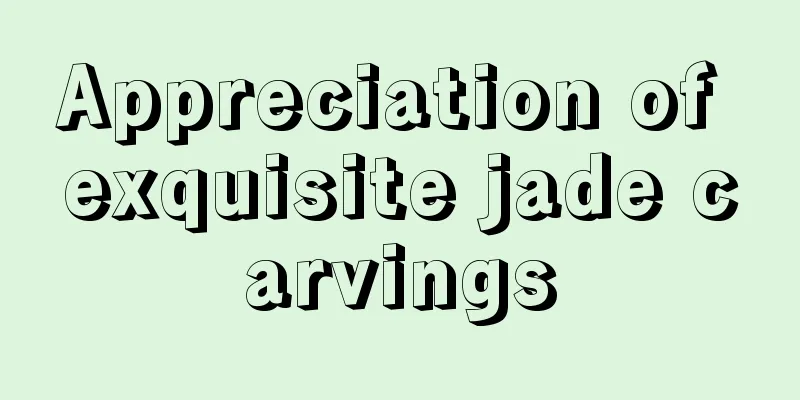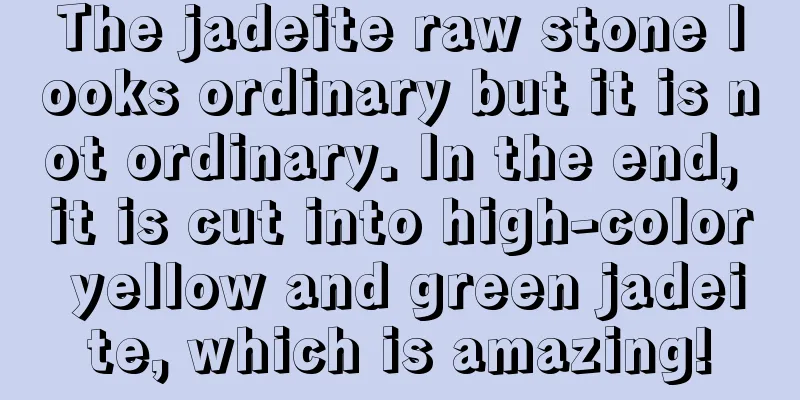If you don’t know the meaning of these jade shapes, how dare you wear them casually?

|
Jade, as a unique traditional culture of our country, has been passed down for nearly 8,000 years. During the long process of development, jade is no longer simply a piece of beautiful and valuable stone, but has been endowed with more and more cultural attributes. In these cultures, some carvings of fixed shapes are given their own unique meanings, especially the pendants we wear in daily life, which have even more diverse meanings, and these are also important components of jade culture. As someone who likes jade and wears it often, you must understand its meaning. This is how you respect jade culture and won't look inappropriate. Buddhist themesBuddha statues or Buddhist themes are the most common types of jade pendants. This is closely related to religious culture and also reflects people's pursuit of a better life. Buddhism is very particular about wearing certain objects, and if you are not careful, you may violate some taboos. So, let’s start with Buddhism. Laughing Buddha: Be Kind to Others“Be broad-minded and be able to tolerate things that are difficult to tolerate in the world. Open your mouth and laugh, and laugh at the ridiculous people in the world.” Wearing a Laughing Buddha represents that the wearer is tolerant, optimistic and open-minded, and can keep a calm mind no matter in good or bad times. It also expresses the wearer's beautiful vision of pursuing everything going well and a happy life. Guanyin: Saving All Living BeingsGuanyin is an important representative figure in Buddhism and is also the most common carving subject in jade pendants. According to legend, Guanyin once made a vow: when encountering difficulties, one only needs to recite the holy name of Guanyin Bodhisattva devoutly to be saved. Therefore, there is also the saying of "Guanyin who saves the suffering and the distressed". For thousands of years, Guanyin has become a symbolic image of amulet, so wearing jade Guanyin is also praying for protection. In addition to Buddhist themes, there are also many images in our traditional culture that convey auspicious meanings, and these are well reflected in jade pendants. Dragon: Full powerIn ancient times, the dragon was the symbol of the emperor, power and majesty. In ancient times, the jade dragon pendant represented royal power and majesty. Today, it implies that the wearer can hold great power and be respected and supported by others. It is especially suitable for successful people or those pursuing a successful career. Ruyi: as one wishesRuyi is one of my country's traditional auspicious objects. The most common Ruyi we see are probably in major costume TV dramas, especially Qing palace dramas. The emperor would often give Ruyi as a reward to concubines or ministers, and most of them were jade Ruyi. "As you wish, as I wish." I believe almost everyone can say this. This is also the reason why Ruyi is so popular. It means what people want, hence the name "Ruyi". At the same time, its design adds auspicious cloud shapes, giving it the meaning of good luck and exorcism. But when talking about Ruyi, most people will think of the long-handled shape in the picture. But the jade Ruyi is not like this. This long handle is obviously not suitable for wearing on the body. The shape of the jade Ruyi has been adjusted to become more round, small and exquisite, but the auspicious cloud pattern is still retained. Pixiu: Good fortune and wealth"With a Pixiu in hand, you can make money easily; with a Pixiu at home, you will have no worries" As a mythical beast that brings wealth, the Pixiu symbolizes attracting wealth and absorbing fortune from all directions. With such a symbolic meaning, it is of course very popular, and has become one of the common shapes of jade pendants. Peace buckle: peace is blessingIn traditional Chinese culture, "circle" is a particularly auspicious shape. Perfection and reunion are both manifestations of this culture. The jadeite that best embodies this culture is the peace locket. The peace locket is a traditional mascot. Its round and flexible appearance conforms to the "golden mean" in traditional Chinese culture. It also expresses perfection, peace and smoothness. It is often used to express good wishes for attracting wealth and good luck, curing diseases and disasters, ensuring safety and good fortune, and increasing family fortune. Leaves: Life and hope"叶" sounds the same as "业", which is related to career. Therefore, adult men often wear it to pray for a smooth career and great success. Men who are doing business or pursuing a career in politics will choose to wear it. In addition, leaves also symbolize thriving vitality and hope, so it can be worn by children, expressing the beautiful hope that the children will grow up smoothly and thrive. Gourd: Good fortune and luckDo you remember the classic line in "Journey to the West": "If I call you, will you answer?" The protagonist here is the magical gourd. Although it is a magic tool, it also reflects the extraordinary status of the gourd in our traditional culture. In fact, the gourd has always been a traditional mascot because of its round and full shape with two connected balls, which symbolizes auspiciousness and perfection. It also symbolizes the love between husband and wife or harmonious relationship. The shape of the big belly and small mouth coincides with the restraint and implicitness in Chinese culture. It also symbolizes attracting wealth and keeping wealth from flowing out. At the same time, the gourd also has the function of warding off evil spirits. With so many beautiful connotations, gourds are naturally very popular among people and have become a common carving on jade pendants. fcgc66 fcpf18 |
<<: It turns out that jade of different colors has different meanings? I really learned a lot!
>>: Jadeite collection, investing in fine products has a future
Recommend
The Qingshui jadeite you missed in those years, from the raw stone to the finished product, has an extremely icy and transparent feel and is magnificent!
When we usually talk about the type of jadeite ra...
Nowadays, more and more people like to collect jade ornaments. Do you know the categories and meanings of jade ornaments?
Many people like to place some ornaments at home,...
What is the meaning of jade jewelry?
Since jadeite was introduced to China, it opened ...
Jade's "Three Taboos and Four Fears", Understand Your Jade
Jade is now almost the "national sweetheart&...
This kind of bracelet actually has a crown on it. This is the first time I’ve seen it!
Jade bracelets have been one of the most basic wr...
"Good jade"! Jade that meets these “seven requirements”!
Jade has a complex structure and comes in many va...
The "Yu the Great Taming the Flood" is a treasure in the Palace Museum's collection, a rare jade carving and a national treasure!
There are so many treasures in the collection of ...
Appreciate the rare jadeite in auction history, top quality, rarely seen
Since ancient times, jade has been loved by the C...
There are so many types of jewelry, which ones will become more beautiful the more you wear them?
In recent years, with the improvement of people&#...
Are you afraid of being cheated by the Jade Fairy Picture? Come and learn from the masters to develop your Fiery Eyes and Golden Pupils!
The liar won’t take a holiday unless the earth ex...
What kind of blue water jade is good?
There are many ways to classify jade, and there a...
Appreciate the transformation process of jadeite rough stone into finished product
Today I would like to share with you a piece of M...
Experts explain in detail how the labor costs of jade carving are calculated, so you can better understand the pricing of jade!
Jade is loved by many people because of its uniqu...
The humble jade bracelet core, after some design and processing, is completely beyond your expectations!
Bracelets are one of the jade ornaments that wome...
Investment and Collection of Jadeite
Now let’s discuss with you the topic of jade inve...









